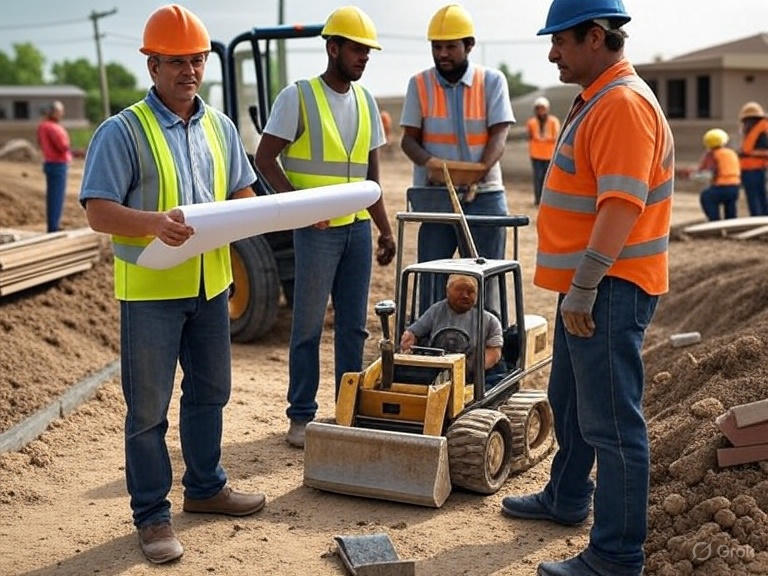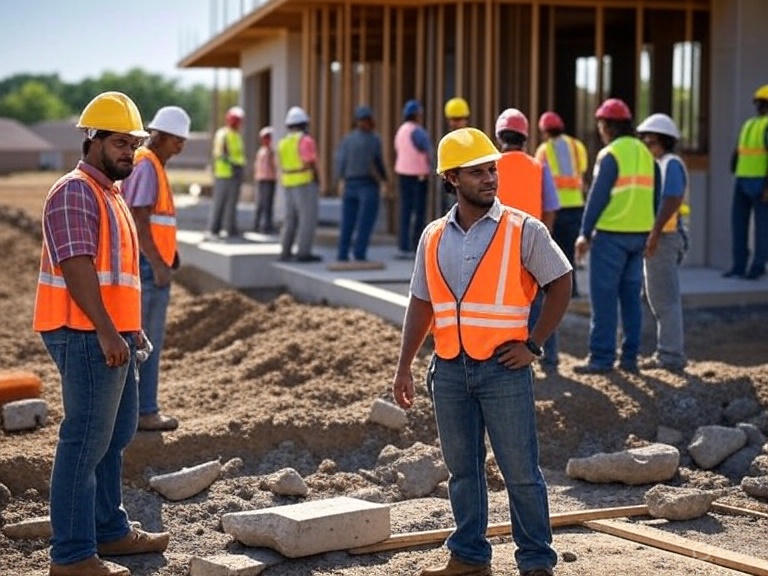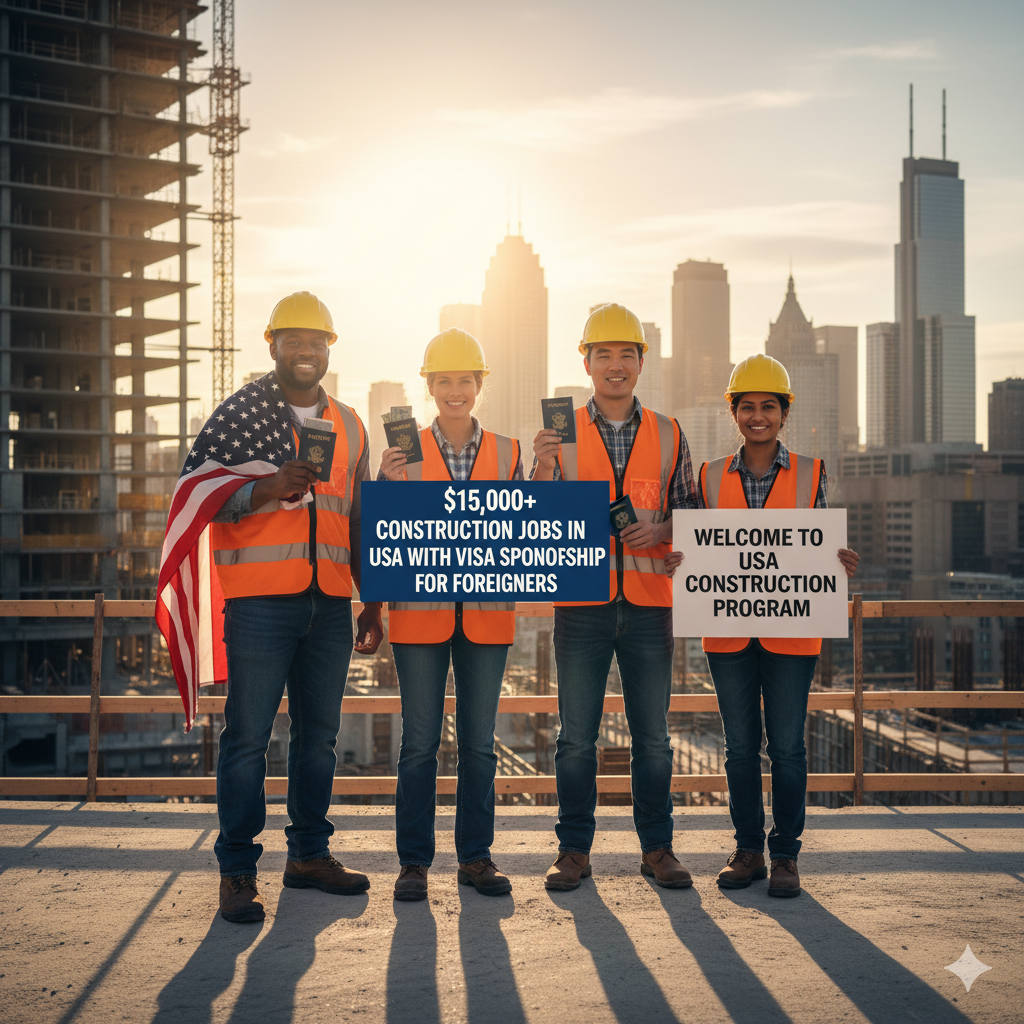Are you a skilled tradesperson or a construction professional dreaming of taking your career global? The United States construction industry is booming, creating an urgent, nationwide demand for talent and this demand extends well beyond American borders.
For foreigners seeking a path to the American Dream, this is more than just a job market; it’s an opportunity. We’re talking about high-paying construction jobs in the USA that come with the highly coveted advantage of visa sponsorship. While the figure in the title might catch your eye, we’ll quickly clarify what salaries really look like in this sector and how you can secure a role that pays or more.
This comprehensive guide is your blueprint. We’ll break down the salary expectations, the necessary visa pathways, and the exact steps you need to take to secure a sponsored construction role in the land of opportunity.
The American Construction Job BOOM: Why Foreign Talent is Essential

The United States is currently undertaking massive infrastructure projects, from revitalizing aging roadways and bridges to building cutting-edge commercial properties and modern residential complexes. This unprecedented level of activity has created a significant labor shortage across almost every construction trade.
This isn’t a temporary spike; it’s a sustained demand driven by federal funding for infrastructure and consistent economic growth.
The Skills Gap is Your Opportunity
American companies are struggling to find qualified workers to fill specialized and leadership roles. They need experienced carpenters, electricians, specialized welders, mechanical engineers, and seasoned project managers.
This critical skills gap is precisely why many US companies are now willing to invest time and money into visa sponsorship for foreign workers. They view international talent not just as a temporary fix but as a long-term solution to maintaining their competitive edge and meeting project deadlines.
If you have proven skills, certifications, and a strong work ethic, you are exactly what the US construction market is looking for. The barriers to entry are lowering, and the financial rewards are higher than ever before.
Decoding Construction Job Salaries: Aiming for (Not )
Let’s get straight to the crucial point regarding salary. The figure of per year for a full-time, sponsored construction job in the USA is highly unrealistic. In fact, it’s far below the federal minimum wage for a full-time worker, and certainly not a figure that would attract a skilled immigrant professional.
A high-paying, sponsored construction role typically targets an annual salary in the to range, depending on the specialization and location.
What High Earning Construction Jobs Roles Look Like
To successfully secure a visa-sponsored role, you need to target jobs that require specialized knowledge or significant experience. These are the positions that command competitive wages, often reaching the bracket:
| Construction Role | Typical Annual Salary Range (USD) | Specialization/Experience Required |
| Construction Project Manager | Bachelor’s degree, 5+ years of management experience, PMP certification. | |
| Construction Superintendent | Overseeing day-to-day operations, safety, and schedules on-site. | |
| Specialized Welder (Pipe/Structural) | High-demand, complex welding certifications (e.g., ASME, AWS). | |
| Master Electrician/Plumber | State licensing, extensive apprenticeship, and complex installation knowledge. | |
| Civil Engineer (Site/Structural) | $$85,000 – | Licensed professional engineer (PE), complex design and planning work. |
The Power of Prevailing Wage
When US companies sponsor foreign workers, they are often required to pay the “prevailing wage.” This is the average wage paid to similarly employed workers in the specific occupation and geographic area. This regulation ensures that immigrant workers are not exploited and helps keep wages fair for all employees.
This rule works in your favor, guaranteeing that your salary will be competitive and aligned with US market standards, often securing you well over the mark for specialized roles.
The Golden Ticket: USA Visa Sponsorship Pathways

Securing a construction job with visa sponsorship is the main hurdle, but it is entirely achievable. Sponsorship means the employer handles the necessary paperwork and petitions to allow you to legally live and work in the United States.
There are primarily two non-immigrant work visas relevant to the construction sector: the H-2B and the H-1B.
The H-2B Visa: For Seasonal or Temporary Workers
The H-2B visa is the most common path for construction laborers and skilled tradespeople who fill non-agricultural, temporary labor needs.
Who it’s for: General laborers, carpenters, roofers, and landscapers.
The requirement: The employer must prove that there are not enough qualified, willing, and available U.S. workers for the temporary job. The job must also be for a specific duration or peak load need.
Key takeaway: Many construction companies rely on this visa to manage their workforce during peak building seasons.
The H-1B Visa: For Highly Specialized Roles
The H-1B visa is reserved for foreign workers in a “specialty occupation,” which typically requires a bachelor’s degree or its equivalent in a specific field.
Who it’s for: Construction Project Managers, Civil Engineers, Quantity Surveyors, Architects, and highly specialized technical roles.
The requirement: Your role must be complex enough that the knowledge required is usually attained through a university degree. This visa is subject to an annual cap and a lottery system, but many companies sponsor it for their high-value technical staff.
The Permanent Path: The EB-3 Visa
For construction workers with specific skills, an employer might be willing to sponsor you for a Green Card (Permanent Residency) through the EB-3 visa for Skilled Workers, Professionals, or Other Workers.
This is the ultimate goal, as it allows you to live and work in the US indefinitely. Your employer must go through the lengthy but rewarding PERM labor certification process. Targeting an employer willing to consider this long-term option is a strategic move for serious candidates.
For more information on the potential earnings and processes for immigrant workers in high-demand sectors, you can explore resources discussing other fields: High-Paying Jobs for Immigrant Workers.
Essential Skills and Qualifications to Secure Sponsorship
Landing a sponsored job, especially one paying six figures, requires you to stand out. Your skills need to be internationally recognized and immediately valuable to a US firm.
Proven Technical Proficiency
Documentation is everything. You must be able to prove your expertise with certifications, detailed work portfolios, and references.
Trades: Certifications from recognized international bodies (like City & Guilds, or equivalent national bodies) for plumbing, electrical work, or welding.
Safety: OSHA (Occupational Safety and Health Administration) certification is non-negotiable in the US. Even a basic 10-hour or 30-hour course completed remotely can significantly boost your resume. It shows you understand American safety standards.
Technology: Proficiency in industry-standard software is key for managers and engineers: AutoCAD, Revit, Primavera P6 (for scheduling), and Microsoft Project.
Language and Communication
While the US construction site is diverse, strong English proficiency is vital, especially for roles that interact with clients, subcontractors, and inspectors (i.e., Project Managers, Superintendents).
Also Read About: $140,000 Dollar Truck Driver Jobs in USA with Visa Sponsorship
Clear communication is crucial for safety and project coordination. If your English is excellent, highlight this on your resume and during interviews.
Transferable Education and Experience
Degrees from recognized international institutions, especially in Civil Engineering or Construction Management, are highly valued. If your role is a specialty occupation (H-1B level), having an accredited degree is mandatory.
Your Step by Step Guide to Landing a US Construction Job
The process of securing a visa-sponsored construction job requires diligence, strategic targeting, and an exceptional resume.
Step 1: Optimize Your Resume for the US Market
The US resume format is specific. It must be concise (usually one or two pages), action-oriented, and quantified.
Quantify Achievements: Instead of “Managed site,” write “Managed a million commercial project, completing it under budget and weeks ahead of schedule.”
Use US Terminology: Ensure your job titles and terminology match the US equivalents (e.g., using “Foreman” or “Superintendent” instead of equivalent foreign titles).
Show Visa Status: Clearly state on your resume that you require visa sponsorship. While some experts advise against this, being upfront saves you and the employer time and targets only the companies willing to sponsor.
Step 2: Target the Right Employers
Not all construction companies sponsor visas. You need to focus on large, national, or international firms that have existing legal departments and a history of immigration filings.
Look for
Companies that specialize in major public works or infrastructure (high demand for labor).
Firms with offices in both the US and your home country (they are already familiar with international transfers).
Companies advertising on job boards specifically mentioning roles like “Superintendent” or “MEP Engineer” these are often H-1B or EB-3 targets.
ALSO READ
Step 3: Leverage International Job Search Platforms
Beyond typical US job sites, look at platforms and organizations that specifically connect international talent with US employers. Attend virtual international career fairs focused on STEM and trades.
When researching international opportunities, it can also be helpful to look at resources for other international career paths, even in different countries or sectors, to understand the general requirements for immigration and work visas: International Student Scholarships or even Teaching Jobs in Canada with Free Visa Sponsorship. These links offer insights into the broader global job landscape.
Step 4: Nail the Remote Interview
Expect remote interviews via video call. Practice discussing US safety regulations, your specific experience with complex building codes, and your ability to work with diverse teams.
Your interview performance is critical. It’s when the employer decides if your skills are worth the investment of visa sponsorship. Be confident, professional, and showcase your understanding of the American construction environment.
Step 5: Understand the Visa Timeline
Be patient. Visa sponsorship takes time. The process can range from a few months (for a specific H-2B filing) to over a year (for a full Green Card process). Stay organized, provide all requested documentation promptly, and keep an open line of communication with your potential employer and their immigration lawyers. Understanding official processes from international government sources, such as The UK Government’s official website, can give you a frame of reference for how immigration systems work globally.
The Future is Built by You
The US construction industry offers one of the most stable and high-paying careers for skilled professionals globally. By targeting the right roles those in the to range and focusing your search on companies with a history of visa sponsorship, you can transition from a dream to a concrete reality.
It takes strategic planning, relentless effort, and a high degree of skill, but the rewards a high salary, a dynamic career, and the chance to build a life in the USA are well worth the effort. Start building your plan today, and you could be building America’s future tomorrow.
Frequently Asked Questions (FAQs)
Q1: Is a construction degree mandatory for visa sponsorship?
A: It depends on the role. For highly specialized jobs like Project Manager, Engineer, or Architect (H-1B visa), yes, a bachelor’s degree (or equivalent experience) is typically mandatory. For skilled trades like carpentry or welding (H-2B or EB-3 Skilled), demonstrable experience and relevant certifications are often sufficient.
Q2: How long does the visa sponsorship process take?
A: The duration varies significantly. An H-2B can be a few months, depending on the filing window. An H-1B is subject to an annual lottery and is usually a 6-month process once selected. The Green Card (EB-3) process can take 1 to 2 years due to the complex labor certification and preference category backlogs.
Q3: Do I have to pay for the visa fees?
A: Legally, the employer must pay most of the costs associated with the H-1B and PERM processes, including attorney fees and various filing fees. For H-2B, the employer also generally covers the costs associated with getting the certification. You may only be responsible for personal costs like passport fees, travel, and a final visa interview fee.
Q4: Can I bring my family with me on a work visa?
A: Yes. If you secure an H-1B visa, your spouse and children under 21 can apply for an H-4 dependent visa. In many cases, H-4 spouses can apply for an Employment Authorization Document (EAD) to work in the US. For the H-2B visa, dependents receive an H-4 visa but are generally not authorized to work.
Conclusion
The journey to securing a high paying construction job in the USA with visa sponsorship is challenging, but the doors are open wider than ever before. Forget the minimum figure; your target should be a specialized role that commands a six-figure salary.
Focus on certifying your skills, optimizing your resume for US recruiters, and targeting the large, well-resourced companies that value international talent. The American infrastructure demands are immense, and skilled workers like you are the engine that will meet them. Start your strategic job search today and lay the foundation for your American success story.
